List of governors of Georgia
From Wikipedia, the free encyclopedia
The governor of Georgia is the head of government of the U.S. state of Georgia and the commander-in-chief of the state's military forces. Republican Brian Kemp assumed office on January 14, 2019.
There have officially been 83 governors of the State of Georgia, including 11 who served more than one distinct term (John Houstoun, George Walton, Edward Telfair, George Mathews, Jared Irwin, David Brydie Mitchell, George Rockingham Gilmer, M. Hoke Smith, Joseph Mackey Brown, John M. Slaton and Eugene Talmadge, with Herman Talmadge serving two de facto distinct terms).
The longest-serving governors are George Busbee, Joe Frank Harris, Zell Miller, Sonny Perdue and Nathan Deal, each of whom served two full four-year terms; Joseph E. Brown, governor during the Civil War, was elected four times, serving seven and a half years. The shortest term of the post-revolutionary period is that of Matthew Talbot, who served 13 days after succeeding his predecessor, who died in office. Eugene Talmadge died in December 1946 before taking office in his second distinct term, leading to a dispute in which three people claimed the office.
Governors
Summarize
Perspective
Georgia was one of the original Thirteen Colonies and was admitted as a state on January 2, 1788.[1] Before it declared its independence, Georgia was a colony of the Kingdom of Great Britain. It seceded from the Union on January 19, 1861,[2] and was a founding member of the Confederate States of America on February 4, 1861.[3] Following the end of the American Civil War, Georgia during Reconstruction was part of the Third Military District, which exerted some control over governor appointments and elections. Georgia was readmitted to the Union on July 25, 1868;[4] again expelled from Congress on March 3, 1869;[5] and again readmitted on July 15, 1870.[6]
The Rules and Regulations of the Colony, drafted in 1776, provided for a president to serve a term of 6 months.[7] A formal constitution was drafted in 1777, providing for a governor to serve a term of one year, but no more than one year out of every three.[8] The term was lengthened to two years in 1789, but with no term limit.[9] The 1865 constitution required governors to take four years off after serving two terms,[10] but that was quickly changed in the 1868 constitution, which allowed four-year terms with no limits.[11] The term length was returned to the two-year term and limit of the 1865 constitution in 1877.[12]
The 1945 constitution changed the length of terms to four years, with governors required to take four years off before running again, and it created the office of Lieutenant Governor of Georgia, who would exercise the powers of the governor should the office become vacant.[13] This was changed in 1983 so that the lieutenant governor fully becomes governor in that circumstance.[14] Before the creation of the office of lieutenant governor, the president of the senate (or, before 1789, the president of the executive council[15]) would exercise the powers of governor.[16] The 1983 constitution also allows governors to succeed themselves once, before having to wait four years to run again.[14] The governor and the lieutenant governor are not officially elected on the same ticket.
| No.[a] | Governor | Term in office | Party | Election | Lt. Governor[b][c] | |||
|---|---|---|---|---|---|---|---|---|
| 7 |  |
Archibald Bulloch (1730–1777) [18][19] |
January 22, 1776[20] – February 22, 1777 (died in office) |
None | —[d] | Office did not exist | ||
| 8 |  |
Button Gwinnett (1735–1777) [21][22] |
March 4, 1777[20] – May 8, 1777 (left office)[e] |
None | —[f] | |||
| 9 |  |
John A. Treutlen (1734–1782) [23][24] |
May 8, 1777[20] – January 10, 1778 (left office)[e] |
None | — | |||
| 10 |  |
John Houstoun (1744–1796) [25][26] |
January 10, 1778[20] – December 29, 1778 (fled from capture)[g] |
None | — | |||
| — | Competing governments | December 29, 1778 – August 6, 1779 |
Government in chaos after fall of Savannah[h] | |||||
| 11 |  |
John Wereat (d. 1799) [29][30] |
August 6, 1779[20] – November 1779 (left office)[e] |
None | — | |||
| 12 |  |
George Walton (d. 1804) [31][32][33] |
November 1779[20] – January 4, 1780 (left office)[e] |
None | — | |||
| 13 |  |
Richard Howly (1740–1784) [34] |
January 4, 1780[20] – February 5, 1780 (left office)[i] |
None | — | |||
| — |  |
George Wells (d. 1780) |
February 5, 1780 – February 16, 1780 (died in office)[j] |
None | — | |||
| 14 |  |
Stephen Heard[k] (1740–1815) [37][36] |
February 18, 1780[l] – August 18, 1781 (left office)[e] |
None | — | |||
| 15 |  |
Nathan Brownson (1742–1796) [39][40] |
August 18, 1781[20] – January 3, 1782 (term-limited)[m] |
None | 1781 | |||
| 16 |  |
John Martin (d. 1786) [42][43] |
January 3, 1782[20] – January 8, 1783 (term-limited)[m] |
None | 1782 | |||
| 17 | 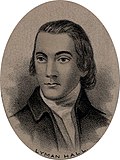 |
Lyman Hall (1724–1790) [44][45] |
January 8, 1783[20] – January 9, 1784 (term-limited)[m] |
None | 1783 | |||
| 10 |  |
John Houstoun (1744–1796) [25][26] |
January 9, 1784[20] – January 6, 1785 (term-limited)[m] |
None | 1784 | |||
| 18 |  |
Samuel Elbert (1740–1788) [46][47] |
January 6, 1785[20] – January 9, 1786 (term-limited)[m] |
None | 1785 | |||
| 19 |  |
Edward Telfair (1735–1807) [48][49][50] |
January 9, 1786[20] – January 9, 1787 (term-limited)[m] |
None | 1786 | |||
| 20 |  |
George Mathews (1739–1812) [51][52][53] |
January 9, 1787[20] – January 26, 1788 (term-limited)[m] |
None | 1787 | |||
| 21 |  |
George Handley (1752–1793) [54][55] |
January 26, 1788[20] – January 7, 1789 (term-limited)[m] |
None | 1788[n] | |||
| 12 |  |
George Walton (d. 1804) [31][32][33] |
January 7, 1789[20] – November 9, 1789 (did not run)[o] |
Democratic- Republican[31] |
Jan. 1789 | |||
| 19 |  |
Edward Telfair (1735–1807) [48][49][50] |
November 9, 1789[20] – November 7, 1793 (lost election) |
Democratic- Republican[48] |
Nov. 1789[p] | |||
| 1791 | ||||||||
| 20 |  |
George Mathews (1739–1812) [51][52][53] |
November 7, 1793[20] – January 15, 1796 (did not run) |
Democratic- Republican[51] |
1793 | |||
| 22 | 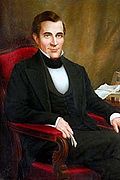 |
Jared Irwin (1750–1818) [58][59][60] |
January 15, 1796[20] – January 12, 1798 (did not run) |
Democratic- Republican[61] |
1795 | |||
| 23 |  |
James Jackson (1757–1806) [56][62][63] |
January 12, 1798[20] – March 3, 1801 (resigned)[q] |
Democratic- Republican[61] |
1797 | |||
| 1799 | ||||||||
| 24 |  |
David Emanuel (1744–1808) [64][65][66] |
March 3, 1801[20] – November 7, 1801 (did not run) |
Democratic- Republican[61] |
Succeeded from president of the Senate | |||
| 25 |  |
Josiah Tattnall (d. 1803) [67][68][69] |
November 7, 1801[20] – November 4, 1802 (resigned)[r] |
Democratic- Republican[61] |
1801 | |||
| 26 |  |
John Milledge (1757–1818) [70][71][72] |
November 4, 1802[20] – September 23, 1806 (resigned)[s] |
Democratic- Republican[61] |
1802 (special)[t] | |||
| 1803 | ||||||||
| 1805 | ||||||||
| 22 |  |
Jared Irwin (1750–1818) [58][59][60] |
September 23, 1806[20] – November 10, 1809 (lost election) |
Democratic- Republican[61] |
Succeeded from president of the Senate | |||
| 1807 | ||||||||
| 27 |  |
David Brydie Mitchell (1766–1837) [74][75][76] |
November 10, 1809[20] – November 5, 1813 (did not run)[74] |
Democratic- Republican[61] |
1809 | |||
| 1811 | ||||||||
| 28 |  |
Peter Early (1773–1817) [77][78][79] |
November 5, 1813[20] – November 10, 1815 (lost election) |
Democratic- Republican[61] |
1813 | |||
| 27 |  |
David Brydie Mitchell (1766–1837) [74][75][76] |
November 10, 1815[20] – March 4, 1817 (resigned)[u] |
Democratic- Republican[61] |
1815 | |||
| 29 |  |
William Rabun (1771–1819) [80][81][82] |
March 4, 1817[20] – October 24, 1819 (died in office) |
Democratic- Republican[61] |
Succeeded from president of the Senate | |||
| 1817 | ||||||||
| 30 |  |
Matthew Talbot (1767–1827) [83] |
October 24, 1819[20] – November 5, 1819 (successor took office) |
Democratic- Republican[61] |
Succeeded from president of the Senate | |||
| 31 |  |
John Clark (1766–1832) [84][85][86] |
November 5, 1819[20] – November 7, 1823 (did not run) |
Democratic- Republican[61] |
1819 | |||
| 1821 | ||||||||
| 32 |  |
George Troup (1780–1856) [87][88][89] |
November 7, 1823[20] – November 7, 1827 (did not run) |
Troup Democratic- Republican[90] |
1823 | |||
| 1825 | ||||||||
| 33 | 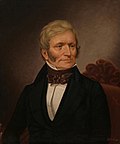 |
John Forsyth (1780–1841) [91][92][93] |
November 7, 1827[20] – November 4, 1829 (did not run)[v] |
Troup Democratic- Republican[90] |
1827 | |||
| 34 |  |
George Rockingham Gilmer (1790–1859) [94][95][96] |
November 4, 1829[20] – November 9, 1831 (lost election) |
Troup Democratic- Republican[97] |
1829 | |||
| 35 |  |
Wilson Lumpkin (1783–1870) [98][99][100] |
November 9, 1831[20] – November 4, 1835 (did not run) |
Union (Democratic)[101] |
1831 | |||
| 1833 | ||||||||
| 36 |  |
William Schley (1786–1858) [102][103][104] |
November 4, 1835[20] – November 8, 1837 (lost election) |
Union (Democratic)[105] |
1835 | |||
| 34 |  |
George Rockingham Gilmer (1790–1859) [94][95][96] |
November 8, 1837[20] – November 6, 1839 (did not run) |
State Rights (Whig)[105] |
1837 | |||
| 37 |  |
Charles James McDonald (1793–1860) [106][107][108] |
November 6, 1839[20] – November 8, 1843 (did not run) |
Union (Democratic)[109] |
1839 | |||
| 1841 | ||||||||
| 38 | 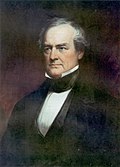 |
George W. Crawford (1798–1872) [110][111][112] |
November 8, 1843[20] – November 3, 1847 (did not run)[112] |
Whig[113] | 1843 | |||
| 1845 | ||||||||
| 39 |  |
George W. Towns (1801–1854) [114][115][116] |
November 3, 1847[20] – November 5, 1851 (did not run) |
Democratic[117] | 1847 | |||
| 1849 | ||||||||
| 40 |  |
Howell Cobb (1815–1868) [118][119][120] |
November 5, 1851[20] – November 9, 1853 (did not run) |
Constitutional Union (Democratic)[w] |
1851 | |||
| 41 |  |
Herschel V. Johnson (1812–1880) [122][123][124] |
November 9, 1853[20] – November 6, 1857 (did not run) |
Democratic[125] | 1853 | |||
| 1855 | ||||||||
| 42 |  |
Joseph E. Brown (1821–1894) [126][127][128] |
November 6, 1857[20] – June 17, 1865 (resigned)[x] |
Democratic[130] | 1857 | |||
| 1859 | ||||||||
| 1861 | ||||||||
| 1863 | ||||||||
| 43 | 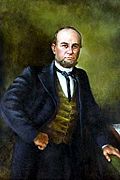 |
James Johnson (1811–1891) [131][132][133] |
June 17, 1865[20] – December 19, 1865 (provisional term ended)[y] |
Provisional governor appointed by President[z] | ||||
| 44 |  |
Charles J. Jenkins (1805–1883) [134][135][136] |
December 14, 1865[20] – January 13, 1868 (removed from office)[aa] |
Democratic[90] | 1865 | |||
| 45 |  |
Thomas H. Ruger (1833–1907) [137][138][139] |
January 13, 1868[20] – July 4, 1868 (state readmitted) |
Military occupation[ab] | ||||
| 46 |  |
Rufus Bullock (1834–1907) [140][141][142] |
July 4, 1868[ac] – October 30, 1871 (resigned)[ad] |
Republican[129] | 1868[ae] | |||
| 47 |  |
Benjamin F. Conley (1815–1886) [145][146] |
October 30, 1871[20] – January 12, 1872 (successor took office) |
Republican[147] | President of the Senate acting | |||
| 48 |  |
James Milton Smith (1823–1890) [148][149][150] |
January 12, 1872[20] – January 12, 1877 (did not run) |
Democratic[147] | 1871 (special)[af] | |||
| 1872 | ||||||||
| 49 |  |
Alfred H. Colquitt (1824–1894) [151][152][153] |
January 12, 1877[154] – November 4, 1882 (did not run) |
Democratic[147] | 1876 | |||
| 1880[ag] | ||||||||
| 50 |  |
Alexander H. Stephens (1812–1883) [156][157][158] |
November 4, 1882[159] – March 4, 1883 (died in office) |
Democratic[147] | 1882 | |||
| 51 |  |
James S. Boynton (1833–1902) [160][161] |
March 4, 1883[ah] – May 10, 1883 (successor took office) |
Democratic[147] | President of the Senate acting | |||
| 52 |  |
Henry Dickerson McDaniel (1836–1926) [163][164][165] |
May 10, 1883[166] – November 9, 1886 (did not run)[ai] |
Democratic[147] | 1883 (special)[aj] | |||
| 1884 | ||||||||
| 53 | 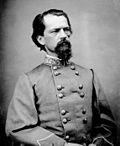 |
John B. Gordon (1832–1904) [167][168][169] |
November 9, 1886[170] – November 8, 1890 (term-limited)[ak] |
Democratic[147] | 1886 | |||
| 1888 | ||||||||
| 54 |  |
William J. Northen (1835–1913) [172][173][174] |
November 8, 1890[175] – October 27, 1894 (term-limited)[ak] |
Democratic[147] | 1890 | |||
| 1892 | ||||||||
| 55 |  |
William Yates Atkinson (1854–1899) [176][177][178] |
October 27, 1894[179] – October 29, 1898 (term-limited)[ak] |
Democratic[147] | 1894 | |||
| 1896 | ||||||||
| 56 |  |
Allen D. Candler (1834–1910) [180][181][182] |
October 29, 1898[183] – October 25, 1902 (term-limited)[ak] |
Democratic[147] | 1898 | |||
| 1900 | ||||||||
| 57 |  |
Joseph M. Terrell (1861–1912) [184][185][186] |
October 25, 1902[187] – June 29, 1907 (term-limited)[ak] |
Democratic[147] | 1902 | |||
| 1904[al] | ||||||||
| 58 |  |
M. Hoke Smith (1855–1931) [188][189][190] |
June 29, 1907[191] – June 26, 1909 (lost nomination)[188] |
Democratic[147] | 1906 | |||
| 59 |  |
Joseph Mackey Brown (1851–1932) [192][193][194] |
June 26, 1909[195] – July 1, 1911 (lost election)[am] |
Democratic[147] | 1908 | |||
| 58 |  |
M. Hoke Smith (1855–1931) [188][189][190] |
July 1, 1911[196] – November 15, 1911 (resigned)[an] |
Democratic[147] | 1910 | |||
| 60 |  |
John M. Slaton (1866–1955) [197][198][199] |
November 15, 1911[ao] – January 25, 1912 (successor took office) |
Democratic[147] | President of the Senate acting | |||
| 59 |  |
Joseph Mackey Brown (1851–1932) [192][193][194] |
January 25, 1912[201] – June 28, 1913 (did not run) |
Democratic[147] | 1912 (special)[ap] | |||
| 60 |  |
John M. Slaton (1866–1955) [197][198][199] |
June 28, 1913[202] – June 26, 1915 (did not run) |
Democratic[147] | 1912 | |||
| 61 |  |
Nathaniel Edwin Harris (1846–1929) [203][204][205] |
June 26, 1915[206] – June 30, 1917 (lost nomination)[203] |
Democratic[147] | 1914 | |||
| 62 | 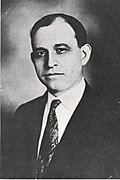 |
Hugh Dorsey (1871–1948) [207][208][209] |
June 30, 1917[210] – June 25, 1921 (term-limited)[ak] |
Democratic[147] | 1916 | |||
| 1918 | ||||||||
| 63 | 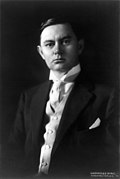 |
Thomas W. Hardwick (1872–1944) [211][212][213] |
June 25, 1921[214] – June 30, 1923 (lost nomination)[211] |
Democratic[147] | 1920 | |||
| 64 |  |
Clifford Walker (1877–1954) [215][216][217] |
June 30, 1923[218] – June 25, 1927 (term-limited)[ak] |
Democratic[147] | 1922 | |||
| 1924 | ||||||||
| 65 |  |
Lamartine Griffin Hardman (1856–1937) [219][220][221] |
June 25, 1927[222] – June 27, 1931 (term-limited)[ak] |
Democratic[147] | 1926 | |||
| 1928 | ||||||||
| 66 |  |
Richard Russell Jr. (1897–1971) [223][224][225] |
June 27, 1931[226] – January 10, 1933 (did not run)[aq] |
Democratic[147] | 1930[ar] | |||
| 67 |  |
Eugene Talmadge (1884–1946) [227][228][229] |
January 10, 1933[230] – January 12, 1937 (term-limited)[ak] |
Democratic[147] | 1932 | |||
| 1934 | ||||||||
| 68 |  |
Eurith D. Rivers (1895–1967) [231][232][233] |
January 12, 1937[234] – January 14, 1941 (term-limited)[ak] |
Democratic[147] | 1936 | |||
| 1938 | ||||||||
| 67 |  |
Eugene Talmadge (1884–1946) [227][228][229] |
January 14, 1941[235] – January 12, 1943 (lost nomination)[227] |
Democratic[147] | 1940 | |||
| 69 |  |
Ellis Arnall (1907–1992) [236][237][238] |
January 12, 1943[239] – January 14, 1947 (term-limited)[as] |
Democratic[147] | 1942[at] | |||
| — |  |
Eugene Talmadge (1884–1946) [227][228][229] |
Died before taking office |
Democratic[147] | 1946[au] | Melvin E. Thompson | ||
| — |  |
Herman Talmadge (1913–2002) [242][243][244] |
January 14, 1947[245] – March 19, 1947 (removed from office)[au] |
Democratic[147] | ||||
| 70 |  |
Melvin E. Thompson (1903–1980) [246][247][248] |
March 19, 1947[249] – November 17, 1948 (lost nomination)[248] |
Democratic[147] | Succeeded from lieutenant governor |
Vacant | ||
| 71 |  |
Herman Talmadge (1913–2002) [242][243][244] |
November 17, 1948[250] – January 11, 1955 (term-limited)[as] |
Democratic[147] | 1948 (special)[au] |
Marvin Griffin | ||
| 1950 | ||||||||
| 72 |  |
Marvin Griffin (1907–1982) [251][252][253] |
January 11, 1955[254] – January 13, 1959 (term-limited)[as] |
Democratic[147] | 1954 | Ernest Vandiver | ||
| 73 |  |
Ernest Vandiver (1918–2005) [255][256][257] |
January 13, 1959[258] – January 15, 1963 (term-limited)[as] |
Democratic[147] | 1958 | Garland T. Byrd | ||
| 74 |  |
Carl Sanders (1925–2014) [259][260][261] |
January 15, 1963[262] – January 11, 1967 (term-limited)[as] |
Democratic[147] | 1962 | Peter Zack Geer | ||
| 75 | 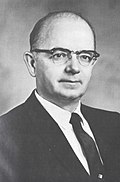 |
Lester Maddox (1915–2003) [263][264][265] |
January 11, 1967[266] – January 12, 1971 (term-limited)[as] |
Democratic[147] | 1966 | George T. Smith | ||
| 76 |  |
Jimmy Carter (1924–2024) [267][268][269] |
January 12, 1971[270] – January 14, 1975 (term-limited)[as] |
Democratic[147] | 1970 | Lester Maddox | ||
| 77 |  |
George Busbee (1927–2004) [271][272][273] |
January 14, 1975[274] – January 11, 1983 (term-limited)[av] |
Democratic[147] | 1974 | Zell Miller | ||
| 1978 | ||||||||
| 78 |  |
Joe Frank Harris (b. 1936) [276][277] |
January 11, 1983[278] – January 14, 1991 (term-limited)[aw] |
Democratic[277] | 1982 | |||
| 1986 | ||||||||
| 79 | 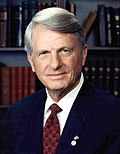 |
Zell Miller (1932–2018) [280][281] |
January 14, 1991[282] – January 11, 1999 (term-limited)[aw] |
Democratic[281] | 1990 | Pierre Howard | ||
| 1994 | ||||||||
| 80 | 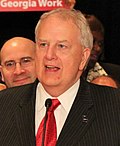 |
Roy Barnes (b. 1948) [283][284] |
January 11, 1999[285] – January 13, 2003 (lost election) |
Democratic[284] | 1998 | Mark Taylor[ax] | ||
| 81 |  |
Sonny Perdue (b. 1946) [286][287] |
January 13, 2003[288] – January 10, 2011 (term-limited)[aw] |
Republican[287] | 2002 | |||
| 2006 | Casey Cagle | |||||||
| 82 |  |
Nathan Deal (b. 1942) [289][290] |
January 10, 2011[291] – January 14, 2019 (term-limited)[aw] |
Republican[290] | 2010 | |||
| 2014 | ||||||||
| 83 | 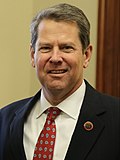 |
Brian Kemp (b. 1963) [292] |
January 14, 2019[293] – Incumbent[ay] |
Republican[292] | 2018 | Geoff Duncan | ||
| 2022 | Burt Jones | |||||||
See also
Notes
- The state says Brian Kemp is the 83rd governor; this number is derived from the Official and Statistical Register of Georgia, last published by the Office of Secretary of State in 1978. It continues the numbering from the colonial governors and omits repeat governors, thus marking Archibald Bulloch as 7th and George Busbee as 77th.[17]
- As speaker of the provincial Congress, Gwinnett was elected by the Council of Safety to succeed Bulloch.[21]
- The date given is the capture of Savannah, where the New Georgia Encyclopedia says his last official act as governor was to flee.[26]
- The capture of Savannah threw the government into disarray and exile, and records are scarce as to dates and leadership. William Glascock (elected January 21, 1779)[27] and Seth John Cuthbert (elected July 24, 1779), while often included in lists of governors, are omitted from the official state register. A school pamphlet from 1977 notes, "This confusing situation resulted in a number of radical Whigs, mainly from Wilkes County, organizing a second government with George Walton as governor and Glascock as speaker of the assembly. ... As a result of this makeshift election, there were two Whig governments plus the restored loyalist government."[28]
- Howly had also been elected as a delegate to the Continental Congress, and the Council voted on February 5 that he must take that seat.[35]
- George Wells succeeded Howly, but was killed in a duel on February 16, 1780; he is omitted from nearly every list of governors, including the official register.[35]
- Some sources say Myrick Davies served as governor in August 1780,[36] but he is omitted from the official state register and it is unknown if this was in an acting fashion.
- The official register says Heard took office on February 18, 1870;[20] an article from 1967 says Humphrey Wells was elected governor on February 16, but declined two days later.[38] Other sources, including the New Georgia Encyclopedia, say Heard did not take office until May 24.[36][37]
- Under the 1777 constitution, governors were ineligible for office for more than one year out of three.[41]
- James Jackson was elected in 1788, but declined the position, citing inexperience.[56]
- Sobel notes that Walton was term-limited under the 1777 constitution;[31] it is unclear if the provisions of that, or the 1789 constitution, would have applied to Walton.
- First term under the 1789 constitution, which lengthened terms to two years.[57]
- Jackson resigned, having been elected to the United States Senate.[62]
- Tattnall resigned due to declining health.[68]
- Milledge resigned, having been elected to the United States Senate.[71]
- Special election for the remainder of Josiah Tattnall's term[73]
- Forsyth was instead elected to the United States Senate.
- Not to be confused with Constitutional Union Party of 1860, the Constitutional Union Party of Georgia was a brief merger of the Democratic and Whig state parties.[121]
- Brown was arrested by Union forces on May 9, 1865, and resigned after he was released.[129]
- Jenkins was removed from office by the military because he refused to allow state funds to be used for a racially integrated state constitutional convention; the state was still under military occupation during Reconstruction.[136]
- Provisional governor appointed by General George Meade[139]
- Bullock was appointed governor on July 4 by General George Meade to replace Ruger, who was being removed;[143] however, Bullock had already won the election, and would be formally inaugurated into the post on July 21.[140][141]
- First term under the 1868 constitution, which lengthened terms to four years.[11]
- Special election for the remainder of Rufus Bullock's term[149]
- First term under the 1877 constitution, which shortened terms to two years.[155]
- Stephens died on March 4, and Boynton was sworn in on March 5.[162]
- Special election for the remainder of Alexander Stephens' term[164]
- Under the 1877 constitution, governors were ineligible for re-election until four years after the expiration of their second term.[171]
- Brown lost the Democratic nomination to M. Hoke Smith, and ran as an independent.[194]
- Smith resigned, having been elected to the United States Senate.[189]
- Smith resigned on November 15, and Slaton was sworn in on November 16; at least one contemporary news source regarded this as a vacancy rather than an automatic succession.[200]
- Special election for the remainder of Hoke Smith's term[193]
- Russell was instead elected to the United States Senate.
- The start of the term changed from the last Saturday in June to the second Tuesday in January, shortening this term by five months.[224]
- Under the 1945 constitution, governors were ineligible for re-election until the expiration of four years from the end of their term.[240]
- First term under a 1941 amendment to the constitution which lengthened terms to four years.[20]
- Eugene Talmadge was elected to a third term in 1946, but died before taking office. Ellis Arnall, governor at the time, claimed the office, as did Lieutenant Governor Melvin Thompson. The state legislature chose Eugene Talmadge's son, Herman Talmadge, to be governor, but during what came to be called the three governors controversy, the state supreme court declared this unconstitutional and declared Thompson rightful governor, and Talmadge stepped down after 67 days. Talmadge later defeated Thompson in a special election.[241]
- Under the 1976 constitution, governors were ineligible to succeed themselves, or to hold the office until the expiration of four years from the end of their term.[275]
- Under the 1982 constitution, those governors who have succeeded themselves were ineligible to be elected to the office four years after the end of their term.[279]
- Represented the Democratic Party
- Kemp's second term began on January 12, 2023,[294] and will expire on January 11, 2027; he will be term-limited
References
External links
Wikiwand - on
Seamless Wikipedia browsing. On steroids.